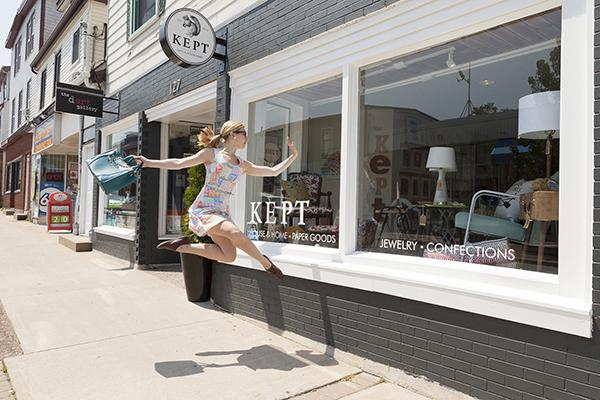Cathy McKelvey is a photographer. Leica Hardy is a choreographer. These two artists came together to create a collection of photographs called D’ance: A Dancer’s view of Dartmouth which are being shown at the Dart Gallery on Portland Street from October 2 to 16.
Read a little about the process, the product and their shared love of Dartmouth here:
Tell us a little about the pictures in the show.
Cathy: We both have strong Dartmouth roots. Having grown up here then been away for many years makes me keenly aware of the changes in the city, while also being very familiar with the landscape. Anyone who knows Dartmouth will recognize the locations, but there is a shocking effect to put a dancer in that otherwise familiar space. For those who are not familiar with Dartmouth it shows them an interesting and unexpected view.
Leica: Continuing on Cathy’s train of thought, I was interested in finding a meaningful relationship between the dancers and the settings. The idea photographing dancers in unusual outdoor locations or urban settings is not unique. There are a number of photographers doing this in major urban centres, but I must say I haven’t felt that many are doing it well. I have seen quite a few where beautiful dancers who were photographed in wonderful settings, but the photo lacked a reason for existing, be it graphic or narrative, or for placing the dancer in that particular setting. So I wanted to experiment with the iconic locations of Dartmouth and finding meaningful ways to connect the dancers to the spaces as the primary reason for the photograph. As well, my home and dance school are both in Dartmouth, and I feel strongly about the quality of life we have here. I wanted to develop a stronger identity for my school as being part of the artistic heart of the city.
How did you pick the subject matter?
Cathy: Leica originally wanted to hire me to create images of her graduate dancers for her website. The idea was, as the dancers were in town I would do a photo shoot with each. It seconds I knew it would be outrageously expensive to hire me to do this, but I loved the idea of dancers in the landscape. I could see that Leica has a strong connection with Dartmouth. I have had in the back of my mind doing a series about the changes in Dartmouth over the past 50 years. I suggested that if she was interested in working together we could make this into a show.
Leica: Cathy and I made an extensive list of locations that we felt people identified as iconic Dartmouth locations. For me it was a matter of trying to distill my sense of the space. For me the Peace Pavilion was strongly graphic. Dawn MacNutt’s sculptures by the Alderney Landing Library evoked an emotional, humane response. The café, Two If By Sea, is a meeting place for so many Dartmouth residents and therefore it would be a great backdrop for narrative. Then I would match the sensibilities and strengths of my dancers to that specific site, knowing that the dancer would then be able to intuitively understand the ideas and specific vision for each site.
How much of it would you say is showcasing dance and how much Dartmouth?
Cathy: It’s about the interaction of the dancers with the space (landscape). It is also about the interaction of the associations you make with ‘dance’ and the associations you make with ‘Dartmouth’.
Leica: I feel it’s a marriage of the two. The most successful photos are the ones that share ‘centre stage’ equally. What we did in one location with the dancers would not have been appropriate to do in another location. Direct commentary on that space by the dancers and their movements was critical for the project to succeed. Too much emphasis on the dancer and the purpose of the project was lost.
What do you love about the photographs in this exhibit?
Cathy: I love the quirkiness, unexpectedness, imagination, and spirit of it. I love what these dancers are able to do! I love that people who are unfamiliar with Dartmouth say, “Cool, where is that?” I love that they are big and colourful! By printing them on aluminum (to the edge, no border) and floating them on the wall they have a lot impact.
Leica: I love that it is about breaking down the cliché images and ideas people have about dance and dancers. I also love those photos where the dancers are doing very simple things and in a way letting themselves become part of the space. In that way they are contributing more meaning to the space. There is a lot of humour in a number of the photos. When those humourous situations presented themselves it was exciting to see it work.
Can you tell us a little about your process?
Cathy: Leica and I brainstormed locations and talked about what we would do in each. As the dancers were available (many now spend most of the year elsewhere in the world) and the weather forecast looked good. (June – Oct) We booked a time and hoped for good weather. We would begin the shoot with a few setups we had planned and then worked from there. We looked at how the images were working and changed things up to go with what was working. We worked very closely together, ideas going back and forth. I’d shoot some then we’d both look at the back of the camera. Leica would often pick up on something the dancer was doing that was or wasn’t good. She would direct the dancer. I would more often be talking about the quality of the light and the shapes the dancers were making, composition as a whole. Particularly in TIBS the low light made it all the more technically challenging. Sometimes it was just a gut ‘this is or isn’t working’ for both of us.’ More often it was more of a conversation. After the shoot we would get together and look at the photos (1000′s from each shoot) and edit. Earlier this year we decided it was time to wrap it up. We looked at the images so far and tried to create more visual variety in the last few shoots.
Leica: It was very much as Cathy describes. At each location we would discuss what we were trying to achieve. The technical aspects of the photo were Cathy’s responsibilities such as the overall composition, lighting etc. My greatest responsibility was staging the dancers in the photo. I had to be constantly aware of the making sure their movements were timed at the same moment Cathy was taking the shot, making sure they were on their ‘mark’ at the optimal moment, watching for wardrobe, hair and expression details. We also had to be very conscious of the level and angle Cathy was taking the photos from. Generally dancers look best when shot with the camera centred on their waists. So we had to be very careful that the point of view of the camera would enhance and stay true to the dancer’s movement, line and body proportions. I was also the person in charge of watching out for traffic and pedestrians who might cross into the photos. Choosing the photos was very collaborative. If either of us didn’t like an aspect of a photo it was eliminated.
What makes the Dart gallery a good place to view this work?
Cathy: It just makes so much sense to show this work at the Dart Gallery. All of the photos were created within a few kilometres of the gallery. This is the part of Dartmouth I knew as a child. This work is about repositioning our cultural view of Dartmouth. That is what the Dart Gallery is also doing by its very existence.
Leica: It is a way for my school and students to connect themselves to living and dancing in Dartmouth. I am thrilled to be able to connect in this way with other artists and arts organizations such as the Dart Gallery who are contributing to the quality of life in our downtown core. I have always felt that downtown Dartmouth had huge potential to become a cultural centre, which is the hub and anchor for the great quality of life that Dartmouth offers its residents.
Anything else you think people should know…
Cathy: When I think back on this project there are aspects that are all Leica and the dancers and there are aspects that are all me, but there is a huge area in the middle that is a product of our collaboration.
Leica: I think the success of the project is largely due to the fact that we have very similar vision and working styles. We enjoy working together and appreciate the skill sets the other brings to the collaboration.
Cathy: It was a lot of hard work, but it was also a lot of fun. At one point I thanked the dancers for ‘coming out to play’ with us and I meant it!
Join the artists for an opening reception on October 2, 7-9pm at the Dart Gallery, 127a Portland Street, Dartmouth. Exhibit runs until October 16.





